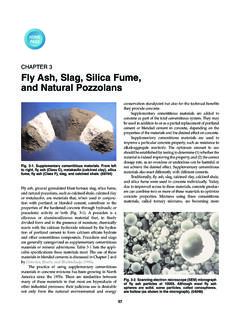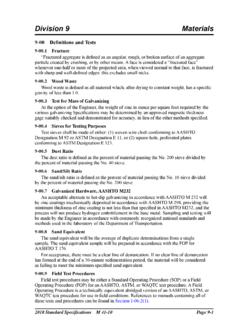Transcription of AMENDMENT NO. 4 MAY 2013 TO IS 456: 2000 PLAIN AND ...
1 Sl. No. Clause Before AMENDMENT After AMENDMENT 1. Aggregates Aggregates shall comply with the requirements of IS 383. As far as possible preference shall be given to natural aggregates. Aggregates shall comply with the requirements of IS 383. 2. Coarse and fine aggregate shall be batched separately. All-in-aggregate may be used only where specifically permitted by the engineer-in-charge. Coarse and fine aggregate shall be batched separately. 3. Water Water used for mixing and curing shall be clean and free from injurious amounts of oils, acids, alkalis, salts, sugar, organic materials or other substances that may be deleterious to concrete or steel. Water, natural or treated, used for mixing and curing shall be clean and free from injurious amounts of oils, acids, alkalis, salts, sugar, organic materials or other substances that may be deleterious to concrete or steel. 4. Sea Water Mixing or curing of concrete with sea water is not recommended because of presence of harmful salts in sea water.
2 Under unavoidable circumstances sea water may be used for mixing or curing in PLAIN concrete with no embedded steel after having given due consideration to possible disadvantages and precautions including use of appropriate cement system. Sea water shall not be used for mixing or curing of concrete because of presence of harmful salts. Under unavoidable circumstances sea water may be used for mixing or curing in PLAIN concrete with no embedded steel after having given due consideration to possible disadvantages and precautions including use of appropriate cement system. 5. New clause added - The amount of admixture added to a mix shall be recorded in the production record. Redosing of admixtures is not normally permitted. In special circumstances, if necessary, additional dose of admixture may be added at a project site and mixed adequately in mixer itself to regain the workability of concrete with the mutual agreement between the producer/supplier and the purchaser/user of concrete.
3 However the producer/supplier shall assure the ultimate quality of concrete supplied by him and maintain record of quantity and time of addition. AMENDMENT NO. 4 MAY 2013 TO IS 456: 2000 PLAIN AND REINFORCE CONCRETE - CODE OF PRACTICE 6. Table 2 Grades of Concrete In this AMENDMENT , Classification of Concrete has been changed. M60Gr. has been shifted to Standard concrete and from Grades M85 to M100 are added to High strength concretes. In note to M55 is replaced with M60. 7. General A durable concrete is one that performs satisfactorily in the working environment during its anticipated exposure conditions during service. The materials and mix proportions specified and used should be such as to maintain its integrity and, if applicable, to protect embedded metal from corrosion. A durable concrete is one that performs satisfactorily in the working environment during its anticipated exposure conditions during service life.
4 The materials and mix proportions specified and used should be such as to maintain its integrity and, if applicable, to protect embedded metal from corrosion. 8. NOTES to Table 5 Minimum Cement Content, Maximum Water-Cement Ratio and Minimum Grade of Concrete for Different Exposures with Normal Weight Aggregates of 20 mm Nominal Maximum Size Cement content prescribed in this table is irrespective of the grades of cement and it is inclusive of additions mentioned in The additions such as fly ash or ground granulated blast furnace slag may be taken into account in the concrete composition with respect to the cement content and water-cement ratio if the suitability is established and as long as the maximum amounts taken into account do not exceed the limit of pozzolona and slag specified in IS 1489 (Part I) and IS 455 respectively. Cement content prescribed in this table is irrespective of grades and types of cement and is inclusive of mineral admixtures mentioned in The mineral admixtures such as fly ash or ground granulated blast furnace slag shall be taken into account in the concrete composition with respect to the cement content and water-cement ratio not exceeding the limit of fly ash and slag specified in IS 1489(Part I) and IS 455 respectively, beyond which these additions though permitted, shall not be considered for these purposes.
5 9. NOTES to Table 5 Note 3 added Only 2 note items mentioned. 3. The minimum cement content, maximum free water-cement ratio and minimum grade of concrete are individually related to exposure. 10. Alkali-aggregate reaction b) Use of low alkali ordinary Portland cement having total alkali content not more than percent (as Na2O equivalent). Further advantage can be obtained by use of fly ash (Grade 1) conforming to IS 3812 or granulated blast furnace slag conforming to IS 12089 as part replacement of ordinary Portland cement (having total alkali content as Na2O equivalent not more than percent), provided fly ash content is at least 20 percent or slag content is at least 50 percent. b) Use of low alkali ordinary Portland cement having total alkali content not more than percent (as Na2O equivalent). Further advantage can be obtained by use of flyash conforming to IS 3812 (Part I) or ground granulated blast furnace slag conforming to IS 12089 as part replacement of ordinary Portland cement (having total alkali content as Na2O equivalent not more than percent), provided fly ash content is at least 25percent or slag content is at least 50 percent.
6 11. Drainage At sites where alkali concentrations are high or may become very high, the ground water should be lowered by drainage so that it will not come into direct contact with the concrete. Additional protection may be obtained by the use of chemically resistant stone facing or a layer of plaster of Paris covered with suitable fabric, such as jute thoroughly impregnated with bituminous material. At sites where alkali concentrations are high or may become very high, the ground water should be lowered by drainage so that it will not come into direct contact with the concrete. Additional protection may be obtained by the use of suitable impermeable barriers. 12. Design Mix Concrete As the guarantor of quality of concrete used in the construction, the constructor shall carry out the mix design and the mix so designed (not the method of design) shall be approved by the employer within the limitations of parameters and other stipulations laid down by this standard.
7 As the guarantor of quality of concrete used in the construction, the constructor shall carry out the mix design and the mix so designed (not the method of design) shall be approved by the employer within the limitations of parameters and other stipulations laid down by this standard. If so desired, the employer shall be provided with supporting data including graphs showing strength versus water cement ratio for range of proportions, complete trial mix proportioning details to substantiate the choice of cement content, fine and coarse aggregate content, water, mineral admixtures, chemical admixtures etc., 13. The mix shall be designed to produce the grade of concrete having the required workability and a characteristic strength not less than appropriate values given in Table 2. The target mean strength of concrete mix should be equal to the characteristic strength plus times the standard deviation. The mix shall be designed to produce the grade of concrete having the required workability and a characteristic strength not less than appropriate values given in Table 2.
8 Proportion/grading of aggregates shall be made by trial in such a way as to make densest possible concrete. The target mean strength of concrete mix should be equal to the characteristic strength plus times the standard deviation. 14. Table 8 Assumed Standard Deviation In this AMENDMENT , M55 and M60 has been added in the amended version to the Grade of Concrete. Also note 2 is added. 15. Batching To avoid confusion and error in batching, consideration should be given to using the smallest practical number of different concrete mixes on any site or in any one plant. In batching concrete, the quantity of both cement and aggregate shall be determined by mass; admixture, if solid, by mass; liquid admixture may however be measured in volume or mass; water shall be weighed or measured by volume in a calibrated tank (see also IS 4925). Ready-mixed concrete supplied by ready-mixed concrete plant shall be preferred. For large and medium project sites the concrete shall be sourced from ready mixed concrete plants or from on site or off site batching and mixing plants (see IS 4926).
9 To avoid confusion and error in batching, consideration should be given to using the smallest practical number of different concrete mixes on any site or in any one plant. In batching concrete, the quantity of both cement and aggregate shall be determined by mass; admixture, if solid, by mass; liquid admixture may however be measured in volume or mass; water shall be weighed or measured by volume in a calibrated tank (see also IS 4925). For large and medium project sites, the concrete shall be sourced from Ready mixed concrete plants or from captive on site or off site automatic batching and mixing plants. The concrete produced and supplied by ready-mixed concrete plants shall be in accordance with IS 4926. In case of concrete from captive on site or off site automatic batching and mixing plants, similar quality control shall be followed. 16. Except where it can be shown to the satisfaction of the engineer-in-charge that supply of properly graded aggregate of uniform quality can be maintained over a period of work, the grading of aggregate should be controlled by obtaining the coarse aggregate in different sizes and blending them in the right proportions when required, the different sizes being stocked in separate stock-piles.
10 The material should be stock-piled for several hours preferably a day before use. The grading of coarse and fine aggregate should be checked as frequently as possible, the frequency for a given job being determined by the engineer-in charge to ensure that The grading of aggregate shall be controlled by obtaining the coarse aggregate in different sizes and blending them in right proportions, the different sizes being stocked in separate stock piles. The material should be stock-piled for several hours preferably a day before use. The grading of coarse and fine aggregate should be checked as frequently as possible, the frequency for a given job being determined by the engineer-in charge to ensure that the specified grading is maintained. the specified grading is maintained. 17. The accuracy of the measuring equipment shall be within + 2 percent of the quantity of cement being measured and within + 3 percent of the quantity of aggregate, admixtures and water being measured.



